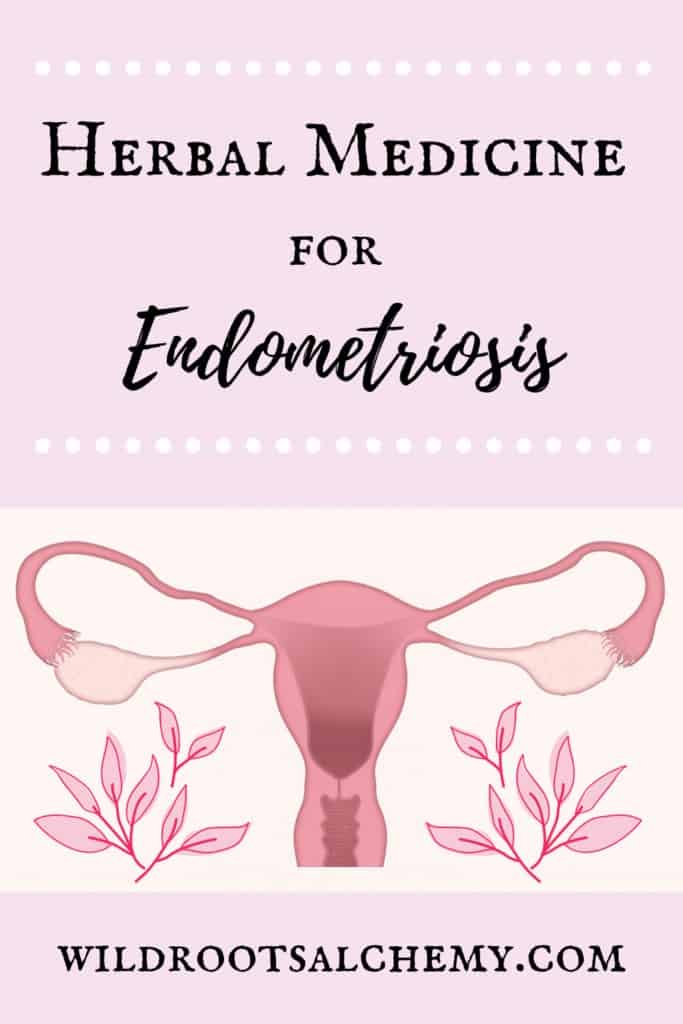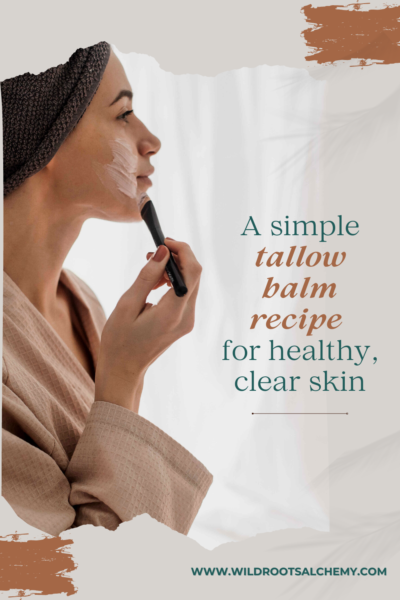
March is Endometriosis Awareness Month and yesterday was International Women’s Day. So for this week’s blog post, I’m going to talk about endometriosis: a super common, yet under-diagnosed condition that affects so many women around the world. We’ll dive into the pathophysiology and clinical presentation of endometriosis, along with a bunch of plant allies that can help address the root cause as well as alleviate symptoms. So let’s get on it!
Endometriosis: A Common and Debilitating Condition
Endometriosis affects about 1 in 10 women globally, and I believe that it could be even higher given the symptoms. A woman with endometriosis experiences painful, often debilitating, periods which usually begin in her teenage years. She also may have chronic pelvic pain and experience painful sexual intercourse.
In endometriosis, tissue that is similar to the uterine lining (a.k.a. endometrium) grows outside of the uterus in “ectopic” locations, meaning outside of where the tissue normally belongs. This ectopic tissue reacts to female hormonal fluctuations (the cyclic ups and downs of our sex hormones like estrogen and progesterone) just like the endometrial lining inside the uterus, but due to its abnormal placement, it induces chronic inflammation that leads to pain and other signs and symptoms characteristic of endometriosis. The abnormal tissue can even bleed during menstruation, which is why women with endometriosis can have such severe pain with their periods.
Over time, the chronic inflammation can lead to scar tissue that limits mobility of the uterus and surrounding organs, exacerbating the pain and often resulting in infertility. If ectopic endometrial tissue or scar tissue is present near the colon or bladder, a woman may experience constipation, diarrhea, pain with bowel movements, back pain, or urinary pain or frequency. These symptoms can become so severe and painful, affecting every aspect of their lives, that many women opt for hysterectomy to remove the uterus and relieve themselves of the pain.
Despite how common it is, most women suffer in silence. Period pain has become normalized in our society and, as women, we are taught that pain is to be expected, especially if our mothers, grandmothers, and other female figures in our lives had pain too. Getting a diagnosis is usually difficult since transvaginal ultrasounds normally don’t reveal any signs of endometriosis; instead, invasive laparoscopic surgery is needed to visualize the lesions for an accurate diagnosis.
Estrogen: A Necessary Hormone that Gets a Bad Rap
Endometriosis is an estrogen-dependent disease. Estrogen is the hormone that “plumps up” our tissues (think breast tissue, hips, thighs, skin, and lips) and is necessary for building up the lining of our uterus during our menstrual cycle. In excess, however, it promotes abnormal proliferation of endometrial tissue—including that found outside of the uterus.
Endometriosis is often associated with estrogen dominance: a hormonal state in which women have higher levels of estrogen in their bodies compared to progesterone.
So what are the major causes of estrogen dominance?
- Endocrine-disrupting chemicals (i.e. xenoestrogens): Endocrine disruptors are environmental toxins that stimulate our estrogen receptors and create symptoms of estrogen excess. Xenoestrogens can be found in conventional meat and produce, unfiltered tap water, plastics, cleaning products, and cosmetics, just to name a few.
- Low progesterone: This leads to relative estrogen dominance in relationship to low progesterone. Chronic stress is one of the most common reasons progesterone is low, along with adrenal and thyroid issues.
- Poor liver function: Our superhero livers are responsible for clearing hormone metabolites as well as endocrine-disrupting chemicals and other toxins. Poor liver function results in higher levels of estrogen metabolites.
- Obesity: Since estrogen is stored and produced in fat cells, excess body fat can lead to higher levels of estrogen circulating in the body. This is unfortunately a vicious cycle, as estrogen promotes weight gain which then increases your estrogen levels even more.
- Hormonal birth control: The synthetic estrogens in hormonal birth control contribute to estrogen dominance. They also wreak havoc on all of your hormones and every one of your endocrine glands, including your adrenals and thyroid.
Herbal Medicine for Endometriosis
As with all diseases, truly holistic medicine is aimed at treating the individual and not the disease. It is important that a full history be taken in order to accurately identify the root cause and devise an individualized treatment approach. With that being said, SO much can be done to help women with endometriosis, including nutrition, lifestyle changes, herbal medicine, and homeopathy.
Since plants are a love of mine, I will be outlining some key plant allies below for those women who suffer from endometriosis. However, please remember to consult with a naturopathic doctor to discuss all of your options!
Plant Allies to Address Estrogen Dominance
Since estrogen dominance usually plays a significant role in the pathophysiology of endometriosis, it’s important to first figure out WHY you have excess estrogen in the first place. Is it because of environmental toxins? Is it because of stress or hypothalamic-pituitary-adrenal (HPA) axis dysfunction? Perhaps it’s due to poor liver detoxification?
For many women with endometriosis, it’s important to focus on liver health! Hepatic herbal allies can be wonderfully supportive of healthy liver function. Actually, some of my favorite plants to work with are those which have an affinity for the liver. Our liver is an incredibly important organ and it’s vital to keep it happy and healthy!
Here are some examples of hepatic (hepatic = affinity for the liver) plant allies:
- Arctium lappa (Burdock root)
- Taraxacum officinale (Dandelion root)
- Silybum marianum (Milk thistle)
- Cynara scolymus (Artichoke)
- Curcuma longa (Turmeric)
- Mahonia aquifolium (Oregon grape root)
- Chionanthus virginicus (Fringe tree)
Remember that all of these herbs have different energetics and effects, so a formula containing all of these herbs likely would not be nearly as effective as picking herbs with a specific individual’s terrain in mind. For example, for women who tend toward running warm, are overweight, or have high blood pressure or elevated blood sugar or cholesterol, I would probably choose more sedating or cooling hepatics like milk thistle, burdock, and artichoke.
Plant Allies to Alleviate Pelvic Pain
Severe pelvic pain is the most common symptom of endometriosis, and plant medicine has much to offer to help ease the pain. While pain-relieving herbs may not necessarily be addressing the root cause, pain relief is an important step in the process of healing. Engaging with these plants in an energetic sense can also help us work with the pain differently, offering a profound level of healing in the way we perceive pain and allow it to affect us.
Here are some plant allies for alleviating pelvic pain:
- Piscidia spp. (Jamaican dogwood)
- Viburnum opulus (Crampbark)
- Eschscholzia californica (California poppy)
- Zingiber officinale (Ginger)
- Pulsatilla spp. (Pasque flower) — Pulsatilla is a toxic herb when not used in very low doses. For this reason, I prefer using the homeopathic version of the plant in low potency (6C or 12C).
Plant Allies to Decongest a Stagnant Pelvis
Pelvic stagnation can lead to hormonal imbalance, as the ovaries are situated in the pelvis and they are the primary producer of estrogen and progesterone in the body. If blood and lymphatic flow is poor due to pelvic congestion, the ovaries suffer and hormones take a hit.
Some of my favorite plant allies that can help decongest the pelvis are:
- Achillea millefolium (Yarrow)
- Zingiber officinale (Ginger)
- Calendula officinalis (Calendula)
- See my previous blog post on “Botanical Medicine for the Pelvic Bowl” for more about pelvic stagnation and helpful plant allies!
In addition to plant medicine, pelvic floor therapy and Maya abdominal massage are amazing therapies that can help relieve pelvic pain, break up scar tissue, and help you heal from endometriosis! If you can’t get in to see a practitioner, performing abdominal massage on yourself with a healing botanical oil can be an incredible way to practice self-care and alleviate your symptoms.
If you have endometriosis or know someone who does, feel free to comment below and let me know what plants or other therapies have been helpful for you in your healing journey!





